This site is made possible by its sponsors.
Please visit them!
so - In Japanese tradition, a calligraphic term referring to a free or running brushstroke, the so-called 'grass' stroke.
soapstone - Steatite; a soft metamorphic rock composed mostly of the mineral talc. Soapstone is used in China for small figurative sculpture similar to work in jade, and in Byzantium it was used for sculpture similar to work in ivory. In India whole temples with highly ornate carving have been carved of soapstone.
Also see Buddhist and Hindu art.
social realism or Social Realism - A type of realism which is more overtly political in content, critical of society, marked by its realistic depiction of social problems. Paintings by Jean François Millet (French, 1814-75), a painter associated with the Barbizon school, such as The Gleaners (1857, Louvre), is considered an early example of social realism. The greatest impact of this art movement was felt in the first half of the twentieth century, however. Mexican muralists Diego Rivera (1886-1957), José Clemente Orozco (1883-1949), and David Alfaro Siqueiros (1896-1974) strongly influenced many North American social realist and New Deal artists. Some of these northern artists emerged from the Ashcan school, while others, like Ben Shahn (American, 1898-1969), evolved separately. Be careful not to confuse social realism with socialist realism.
Examples of social realist work:

Robert Minor (American, 1884-1952), Morgan,
Mellon, and Rockefeller, c. 1922, grease pencil on paper. The wealthiest
men in America are holding on to their money. Editorial cartoons
like Minor's encouraged the formation of social realism in the
1930s. See cartoon
and drawing.

Ben Shahn (American, born Lithuania, 1898-1969),
The
Passion of Sacco and Vanzetti, 1931-32, tempera
on canvas, 84 1/2 x 48 inches
(214.6 x 121.9 cm), Whitney Museum of American Art, NY. This
painting is from a series of 23 gouaches
titled collectively "The Passion of Sacco and Vanzetti."
They tell the story of the two immigrant Italian anarchists and
their infamous trial and 1927 electrocution for murder and robbery.
Here the two lie in their coffins as those prominent in their
conviction and execution stand by, clad in top hats and formal
dress or in academic robes. Behind them, in a courthouse portico,
is a portrait of Judge Webster Thayer, who presided over the
trial and the appeal process. See Jewish
art and mural.
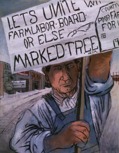
Ben Shahn (American, born Lithuania, 1898-1969),
for the Resettlement Administration
(RA), Lest
We Forget, 1937, gouache
and watercolor
in bound volume, Franklin D. Roosevelt Library, National Archives
and Records Administration. From 1935 to 1938 Ben Shahn worked
for the Farm Security Administration
(FSA) as an artist and photographer. He took over six thousand
photographs
about the life of every day working people in the southern and
middle western states. See New Deal
art.

Ben Shahn, for the Resettlement
Administration (RA), Years of Dust, 1937, photolithograph,
Franklin D. Roosevelt Library, National Archives and Records
Administration.
Raphael Soyer (American, born in Russia, 1899-1987), Entering the Studio, c. 1935, oil on canvas, Columbia Museum of Art, SC.
Philip Evergood (American, 1901-1973), Lily and the Sparrows, 1939, oil on board, 30 x 24 inches (76.2 x 61 cm), Whitney Museum of American Art, NY.
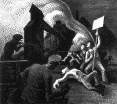
Thomas Hart Benton (American, 1889-1975),
Mine
Strike, lithograph.
Isaac Soyer (American, born Russia, 1907-1981)
Elizabeth Terrell (American, 1908-)
Quote:
Also see American Scene painting and isms and -ism.
socialist realism or Socialist Realism -
Socialist realism was the official style
in the arts in the Soviet Union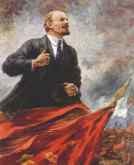 (USSR) from the early 1930s until the decline of Communism in
the 1980s, disappearing entirely by the time of that country's
dissolution in 1989. The onset of socialist realism meant the
end of the avant-garde, notably
in abstraction in such Russian
art movements as by the Constructivist and Suprematism.
The style was a conservative, figurative
and narrative one, meant to
be accessible to all viewers, and never to deviate from the Party
line. In painting and sculpture,
it was devoted to glorifying the state, its leaders (
(USSR) from the early 1930s until the decline of Communism in
the 1980s, disappearing entirely by the time of that country's
dissolution in 1989. The onset of socialist realism meant the
end of the avant-garde, notably
in abstraction in such Russian
art movements as by the Constructivist and Suprematism.
The style was a conservative, figurative
and narrative one, meant to
be accessible to all viewers, and never to deviate from the Party
line. In painting and sculpture,
it was devoted to glorifying the state, its leaders (such as this portrait of Nikolai Lenin,
1870-1924), and the people, idealizing the working class. In architecture, it excluded all but
functional design within a traditional context, in a severe manner
sometimes known as "Stalinist gothic." Be careful not
to confuse socialist realism with social
realism.
Examples:

China, Man on the front of a train, above a Mao slogan: "Forcefully aid agriculture," poster. This and the following two posters
were produced during the People's
Republic of China's period known as the Cultural Revolution,
1966-1976, Burke
Museum, U of WA, Seattle.

China, Man driving a tractor holds
up a copy of Mao's Red Book,
above a Mao quote: "Continuous revolution always going forward," poster,
Burke Museum, U of WA, Seattle.

China, Schoolchildren devote themselves to Mao's writings,
poster, Burke
Museum, U of WA, Seattle.
Also see agitprop, fascist aesthetic, isms and -ism, and propaganda.
socle - A molded projection at the bottom of a wall or a pier, or beneath a pedestal or a column base.
(pr. SOH-kəl)
An example of socle on a pedestal:
![]()
![]()
![]()
Antico (Italian, 1460-1528), Bust of Young Man, Mantua, about 1520,
bronze with silver inlay;
later gilt bronze
drapery, 21 1/2 x 17 3/4
x 8 3/4 inches (54.7 x 45.0 x 22.3 cm), J. Paul Getty Museum,
Malibu, CA. The pedestal-type base
of this bust has a socle.
Also see niche.
soffit - The underside of an architectural member such as an arch, lintel, cornice, or stairway.
(pr. sah'fit)
Also see intrados.

![]()
soft focus - Especially in photography, an image made when the lens is thrown slightly out of sharp focus so that the contours of any object appear moderately soft and blurred. Also see sfumato.
softwoods - Woods from coniferous trees, some of which are suitable for carving — for example, pine and fir.
Also see hardwood and heartwood.
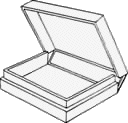 Solander
box or solander box
- A readymade box of acid-free
board. Solander boxes are frequently used for the storage
of books, documents, framed and unframed works on paper, among other objects.
Daniel Charles Solander (English, born Sweden, 1736-1782) was
a botanist who was also a librarian at the British Museum. The
box he designed for the storage of books is known as a Solander
box. Today's conservators
insist on acid-free archival materials
for today's Solander boxes.
Solander
box or solander box
- A readymade box of acid-free
board. Solander boxes are frequently used for the storage
of books, documents, framed and unframed works on paper, among other objects.
Daniel Charles Solander (English, born Sweden, 1736-1782) was
a botanist who was also a librarian at the British Museum. The
box he designed for the storage of books is known as a Solander
box. Today's conservators
insist on acid-free archival materials
for today's Solander boxes.
Also see bin, collection, ephemera, flat file, polypropylene, portfolio, stack tray, and storeroom.
![]()
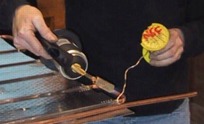
![]() soldering
- A method of joining pieces of metal
by melting an alloy of tin and lead
into the joint to fuse
the two edges together. The
application of a flux
to surfaces to be soldered
is generally required. A soldered joint will not withstand much
stress.
soldering
- A method of joining pieces of metal
by melting an alloy of tin and lead
into the joint to fuse
the two edges together. The
application of a flux
to surfaces to be soldered
is generally required. A soldered joint will not withstand much
stress. Here a person holds the flame of a propane
torch to a piece of solder at the position of the join.
Also see adhesion, temperature and welding.
soluble - Able to be dissolved.
Also see aqueous, solute, solvent and water-soluble.
solute - The material present in the smaller amount in a solution; the substance dissolved in a solution, as distinguished from the solvent. Or (as an adjective) dissolved; in solution. Don't confuse this term with its homonym, salute: a gesture acknowledging another person.
(pr. sə-LOOT)
Also see cleaning, soluble, solve, and water-soluble.
solve - Dissolve.
See detergent, solute, solvent, and water-soluble.
solvent - A (usually) liquid  substance
which is able to solve (dissolve)
another substance,
substance
which is able to solve (dissolve)
another substance, either
for cleaning, thinning, mixing,
or some particular step in an art
technique. Common solvents include
water (especially when soapy), turpentine
and paint thinner, (denatured) alcohol,
acetone, lacquer thinner, toluene, xylene,
plastic cement (model airplane cement), and naphtha. Solvents
are commonly available at hardware stores, as well as at art supply
stores. All
solvents
can be dangerous — most are toxic, volatile, and flammable — so be sure to study their labels carefully, in order to handle,
store,
and dispose
of them properly. Keep them out of the reach of children. The exception to liquid solvents is the solvent for encaustic, which is heat.
Wash eyes and/or skin thoroughly in the event of hazardous exposure to powerful solvents, then consult a physician.
Once an artist has applied a paint to a ground, and its combination of solvent and medium has dried (or oxidized in the case of oils, or cooled in the case of encaustic), s/he expects that it will adhere permanently.
A medium's solvent should not be confused with its vehicle (alternatively called its medium or base).
Also see adhesives, blot, detergent, eraser, eyedropper, fresco, Material Safety Data Sheet (MSDS), poison, polyurethane, smock, soluble, solute, stain and stain removal, Venice turpentine, and water-soluble.
Song - A Chinese dynasty which lasted 960 - 1279, also called the Sung Dynasty. It can be subdivided into the Northern Song dynasty, 960-1126, and the Southern Song dynasty, 1127-1279.
Examples of work of the Song dynasty period:
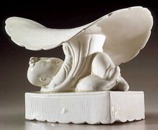
China, Northern Song Dynasty, Pillow in the form of a boy and a lotus leaf,
c. 1000-1200, ding ware, porcelain
with incised decoration,
Asian Art Museum, San Francisco, CA.

China, Xinjiang, Square, 1050-1250, Song dynasty, silk,
on silk, 14 5/8 x 14 7/8 inches (37.15 x 37.78 cm), Metropolitan
Museum of Art, NY.

China, Southern Song dynasty (1127-1279),
Tea bowl stand, brown lacquer
on wood and fabric, Asian Art Museum,
San Francisco, CA.

Mi Fu (Chinese, 1052-1107), Poem Written in a Boat on the Wu River,
Northern Sung dynasty (960-1127), c. 1100, handscroll, ink
on paper, 12 1/4 inches x 18 feet
3 1/4 inches (31.1 x 557 cm), Metropolitan Museum of Art, NY.
See calligraphy
and scroll.

China, Vase with tubular ears, Southern Song
dynasty, Kuan ware, celadon
glazed porcelain,
National Palace Museum, Taipei.

Chinese, Song Dynasty, Mallow-shaped plate in rose purple glaze, glazed porcelain, Jun ware, height 3.3 cm, mouth diameter 19.5 cm, foot diameter 8 cm, Henan Museum, China. Unearthed at Fangcheng, Henan Province. "Jun ware is named after Junzhou where it was produced, and the site of the ruined kiln has been discovered in the present Yuzhou City, Henan Province. The basic colour of the Jun ware is sky blue. The technique of yaobian is often used, which refers to the changes of tints of colours by control of the temperature of the kiln."
Southern Dynasties - See Northern and Southern Dynasties period of Chinese art.
souvenir - Objects collected for the memories they evoke — often sentimental — and likely to remind one of significant people, places, or events. Anything natural or manmade might become a souvenir, although some things are made intentionally to be them: think about objects purchased at tourist destinations or concert venues, often with the name or image of the place or musicians integral to these things. Although many souvenirs could also be called ephemera, kitsch or low art, a seashell, a lock of hair, or a work of fine art might just as thoroughly satisfy a souvenir collector.
Also see bric-a-brac, mass media, memorabilia, popular culture, and poster.
space - An element of art that refers to the distance or area between, around, above, below, or within things. It can be described as two-dimensional or three-dimensional; as flat, shallow, or deep; as open or closed; as positive or negative; and as actual, ambiguous, or illusory.
Examples:


In these images, negative spaces have been shaped and placed among positive spaces so that a viewer can make closure on a triangle, a square, and a cube.

Related link:
Quote:
Also see arrangement, composition, direction, human scale, intercolumniation, kerf, lacuna, letter spacing (and kerning), overlap, perspective, pixel shim, principles of design, straight, theater, and void.
space-time - A concise way of referring to the understanding of the universe as an entity composed of inextricably interwoven space and time; a conception based especially on the theories of Albert Einstein (German-American physicist, 1879-1955). In this view of the universe, anything that happens to alter the condition of space also affects the conditions of time, and vice versa. Mikhail Bakhtin (Russian linguist and literary philosopher, 1895-1975), used the term "chronotope" — literally "time-space" — to designate the space-time matrix that governs all narratives and other linguistic acts.
Also see interdisciplinary, ontology, and science and art.
spandrel - In architecture, the roughly triangular space enclosed by the curves of adjacent arches and a horizontal member connecting their vertices. Also, the space enclosed by the curve of an arch and an enclosing right angle.
spanner - A wrench. (Chiefly a British term.) Also see tool.
spatial qualities - Those aspects of any image or object having to do with the distance or area between, around, above, below, or within things. See space.

spatula - Sometimes called a scraper,
any tool with a blade that
is somewhat flexible, but fairly rigid. It is generally used for
modeling such soft materials
as clay, paint,
plaster, and
wax. Its edge is not honed to
the degree that it would cut or carve
hard materials.
Spatulas can be made in a
variety of sizes,
and typically of metal, plastic, wood,
horn or seashell. Although
their edges are often broad and straight
or curved, scrapers with edges
having other shapes — close
to the contours of surfaces needing scraping — can be very useful. Historically among the
oldest kinds of tools, spatulas are often used for removing materials
from surfaces, for spreading or smoothing them.
can be made in a
variety of sizes,
and typically of metal, plastic, wood,
horn or seashell. Although
their edges are often broad and straight
or curved, scrapers with edges
having other shapes — close
to the contours of surfaces needing scraping — can be very useful. Historically among the
oldest kinds of tools, spatulas are often used for removing materials
from surfaces, for spreading or smoothing them.
Also see chisel and palette knife.
special exhibition - A gathering of museum objects, usually with a particular purpose or theme, for exhibition — public display.
Also see accession, deaccession, donation, gallery, and patron.
specifications - In commisioned works, especially in areas of design, specifications are specific expectations communicated to an artist, designer, fabricator, etc. Whether the entity forming and communicating specifications is a patron or employer, an art director or a teacher, specifications must be communicated clearly in a statement listing such particular requirements of a project as its materials, dimensions, subject or theme, elements or principles of design, quantity, or other qualities of the work expected. Specifications may allow for different interpretations, however, and can even be incomplete or vague in order to provide room for greater creativity. It is generally best to give and receive written specifications, as in a contract providing a record of what the specifications are agreed to be by each of the interested parties. If a work lives up to these parameters, then the work should be considered contractually satisfactory and successful. Related issues might include deadlines, locations, tools or techniques employed, engineering and safety issues, transportation, lodgings, etc.
Also see graphic design.
specific objects - Art that rejects both painting and traditional sculpture. This term was coined by Donald Judd (American, 1928-1994).
Also see combine and Minimalism.
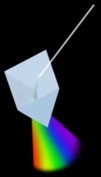
![]() spectrum - A radiant source's emission of a distribution
of energy — colors — arranged in
order of wavelengths. This band
of colors — a range of various kinds of light which might originate from any particular source, such as is produced
when sunlight is refracted and dispersed by a prism — is comprised of red, orange, yellow, green, blue, indigo, and
violet. A rainbow is such a natural display of the visible spectrum.
Of all the colors in the visible spectrum, red has the longest
wavelength at about 700 nanometers. Violet has the shortest at
400 nanometers. Just longer than red is infrared. Just shorter
than violet are ultraviolet and then x-rays. The plural
form can be either spectra or spectrums.
spectrum - A radiant source's emission of a distribution
of energy — colors — arranged in
order of wavelengths. This band
of colors — a range of various kinds of light which might originate from any particular source, such as is produced
when sunlight is refracted and dispersed by a prism — is comprised of red, orange, yellow, green, blue, indigo, and
violet. A rainbow is such a natural display of the visible spectrum.
Of all the colors in the visible spectrum, red has the longest
wavelength at about 700 nanometers. Violet has the shortest at
400 nanometers. Just longer than red is infrared. Just shorter
than violet are ultraviolet and then x-rays. The plural
form can be either spectra or spectrums.
Also see angstrom, color wheel, cool and warm colors, diffraction grating, palette, saturation, and ultraviolet.

![]()

![]()
sphere - A three-dimensional form shaped like a ball, circular from all possible points of view. Its surface
consists of points, all of
which are the same distance (radius)
from its center. Refers both to the surface and to the space
it encloses. The mathematical formula with which to calculate the area of the surface of a sphere: multiply four
times the product of pi times
the radius squared. The volume
of a sphere: 4/3 (or 1.333) times  the
product of pi times the radius cubed. "Sphere" may also refer to the extent
of a person's knowledge, interests,
or social position; or, one's domain — area of power, control,
or influence.
the
product of pi times the radius cubed. "Sphere" may also refer to the extent
of a person's knowledge, interests,
or social position; or, one's domain — area of power, control,
or influence.
Spheres are among the ten classes of patterns.
Examples of spherical works:
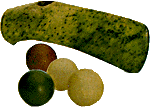
Russia, North Caucasus, Maikop Burial Mound,
Balls
and a Hammer-Axe Head, 3rd millennium
BCE,
stone, diameter
of balls 2.7-3 cm, length
of axe 15.6 cm, Hermitage Museum, St. Petersburg, Russia. See
Stone Age.

Maurits Cornelis Escher (Dutch, 1898-1972),
Hand
with Reflecting Sphere, 1935, lithograph, 32 x 21.5 cm. See mirror, reflection, and self-portrait.
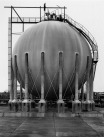
Bernd and Hilla Becher (German, 1931- and
1934-), Sphere,
c. 1960s, black and white
photograph
of a large, steel
storage tank. See technology.

Andy Goldsworthy (English, 1956-), one of
Two
Oak Stacks, 2003, two large balls of stacked and knitted
oak sticks, Storm King Art Center. This ball of sticks is (or
was) directly outside the museum building, visible through the
window of the gallery
where the other identical ball of sticks was constructed and
exhibited. See earth
art, ephemera, and wood.
Also see circle, cone, concave, conglobe, convex, cylinder, hemisphere, Op Art, ovoid, penumbra, pyramid, and spheroid.
spheroid - A three-dimensionalform shaped like a sphere but not perfectly round. An egg is typically a spheroid. Commonly a spheroid is an ellipsoid — generated by revolving an ellipse around one of its axes.
spiral - There are two kinds of spirals: helix
and volute.![]()
![]()
splay - A large bevel or chamfer.
splayed opening - An opening (as in a wall) that is cut away diagonally so that vertical edges (jambs) are farther apart than the inner edges.
Example:
![]()

![]()
England, splayed opening at Pickering
Castle, 12th-14th centuries,
stone masonry.
This slit in the castle wall was built as a splayed opening so
that an archer could stand behind its edges, well protected as
he shot his arrows in a range of directions. This castle is of
a type called motte-and-bailey, and was first built of earth
and timber by William the Conqueror's crew in the years following
the Norman Conquest in the early 1100s.
Also see embrasure.
split complements - One color plus the two colors that are on either side of its complement on the color wheel. For example, the complement of orange is blue, and the two colors on either side of blue are blue-green and blue-violet. Therefore the split complements of orange are blue-green and blue-violet.
Also see analogous colors, camaïeu, color scheme, complementary colors, grisaille, monochrome, split complementary, and triadic colors.
![]()
![]()
![]()
spokeshave - A small planing tool for cutting away a thin slice of wood. It consists of a blade with a handle for each hand at its sides. Also see draw knife.
spontaneity and spontaneous - Spontaneity is the quality of being spontaneous: behavior proceeding from natural feeling or from a momentary impulse, without having been planned or labored; developing from within, without apparent external influence, force, cause, or treatment; not apparently contrived or manipulated. (SPAHN-tə-NAY-ə-tee and spahn-TAY-nee-əs)
Quote:
Also see Abstract Expressionism, aleatory and aleatoric, alla prima, automata, automatism, creativity, encaustic, exquisite corpse, Fluxus, obsession, order, watercolor, and Zen.
![]()

![]()
![]()
springing - In architecture,
the lowest block of stone
of an arch, resting on
the impost block.
Also see
keystone and voussoir.
sprue - In lost-wax casting,
a channel through which molten metal
can enter a mold (runners)
and air and gas can escape (risers).
This term applies to the wax
rods attached to the wax model
that result in the formation of these channels, and for the rods
of metal that may be cast within channels once metal is put into
the mold. In some regions, to attach the wax rods is called spruing,
in others it is called rodding.![]()

![]()
Pictured here is a group of toy soldiers as they came from the mold in which they were cast. You may remember getting plastic toys in pieces, in the manner of these tiny soldiers (American, General Custer and His Troops). If so, you'll probably also recall removing the desired molded parts from the sprues that preserved the path through which liquid plastic reached the mold for each toy part. Here the sprue is the horizontal spine with a little tributary for each piece.
SPS - Acronym for Section of Painting and Sculpture,
one of the U.S. government's bureaucracies which administered
New Deal art programs.
https://inform.quest/_art